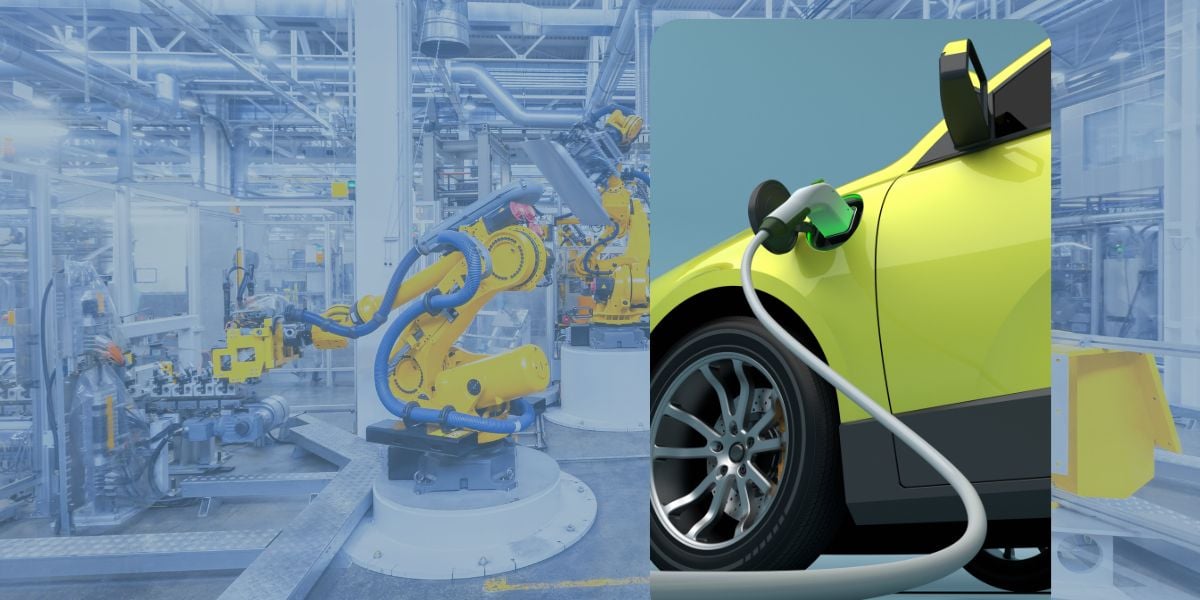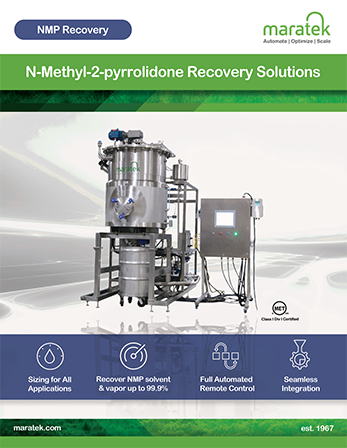What is NMP Solvent?
 NMP is a solvent that’s growing in popularity thanks to its solubility and flashpoint. It’s a key material in manufacturing lithium-ion batteries, but costs of buying and disposing of NMP can quickly add up. With the right technology, NMP can be recycled with 99%+ purity and reused.
NMP is a solvent that’s growing in popularity thanks to its solubility and flashpoint. It’s a key material in manufacturing lithium-ion batteries, but costs of buying and disposing of NMP can quickly add up. With the right technology, NMP can be recycled with 99%+ purity and reused.
NMP is short for N-methyl pyrrolidone, also known as 1-methyl-2-pyrrolidone or N-methyl-2-pyrrolidone. It is a petrochemical solvent used in producing a variety of different products, such as lithium-ion batteries, paint and coating strippers, cleaning agents, electronics, and more. NMP has good chemical stability and thermal stability thanks to its high velocity, low volatility and low toxicity.
NMP is a colorless to slightly yellow liquid that is heavier than water. With a flashpoint of 100 Celsius, NMP doesn’t require explosion-proof facility design as the flashpoint is much higher than the boiling point. The organic compound has a molecular formula of C5H9NO.
NMP is made from reacting monomethylamine (MMA) and gamma-butyraceous (GBL).
How to handle NMP
Safe handling practices
Given its chemical nature, handling NMP requires adherence to specific safety protocols. It is essential to wear appropriate personal protective equipment (PPE), including gloves, goggles, and protective clothing, to avoid skin and eye contact. Work in well-ventilated areas to minimize inhalation risks and use proper respirators if necessary.
Storage guidelines
Store NMP in a cool, dry, and well-ventilated area, away from direct sunlight and heat sources. Ensure that storage containers are tightly sealed and clearly labeled. It is also crucial to follow local regulations for storing chemicals, particularly for substances like NMP.
Spill and leak procedures
In case of a spill or leak, ensure immediate containment and clean-up. Use inert materials like sand or vermiculite to absorb the spill, and dispose of it as hazardous waste according to local environmental regulations. Avoid allowing the solvent to enter waterways or the sewer system.
Disposal and recycling
Disposal of NMP should comply with local environmental regulations. Consider recycling options, as NMP can be effectively recycled and reused, reducing both costs and environmental impact.
Training and awareness
Regular training and awareness programs for employees handling NMP are crucial. These programs should cover proper handling, potential health risks, emergency response procedures, and the importance of personal protective equipment.
By understanding and implementing proper handling and storage practices for NMP, industries can ensure a safer work environment while maximizing the benefits of this versatile solvent. This section provides essential guidelines for industries and professionals who regularly work with NMP, emphasizing safety, regulatory compliance, and environmental responsibility.How is NMP recycled?
NMP can be recycled using a multi-stage distillation process to separate solvents into its components at lower-than-boiling point temperatures. Waste is removed and clean solvent is left. You can expect to recover up to 95% of the used NMP. The battery manufacturer may use upwards of 10,000 to 20,000 NMP per month, which in a year can translate to over 240,000 NMP.
Recycling is an environmental and cost-friendly alternative to buying new NMP and disposing of the used solvent after one use.
With solvent recycling, wasted NMP can be recovered and reused, reducing the cost of buying and disposing of single-use solvent. The recyclability of NMP is a huge benefit as a solvent as it does not pose as a dangerous environmental threat like other solvents when they have been used.
Industry applications of NMP
N-methyl pyrrolidone, known for its excellent solubility and high flashpoint, is increasingly popular in various industries, notably in the manufacturing of lithium-ion batteries. Here are some of the industries it is used in:1. Electronics and Battery Manufacturing
NMP plays a crucial role in the production of lithium-ion batteries, essential for powering modern electronics and electric vehicles. It is particularly effective in dissolving binding materials used in battery electrodes, contributing to the efficiency and reliability of these batteries.
2. Pharmaceuticals
In the pharmaceutical industry, NMP is used for the extraction, purification, and crystallization of various drug ingredients. Its effectiveness as a solvent ensures high purity and quality in pharmaceutical products.
3. Paint and Coating Industry
NMP is a preferred solvent in paint and coating strippers due to its ability to dissolve a wide range of polymers and resins effectively. Its use in this sector underscores its versatility and efficiency.
4. Cleaning Agents
The solvent properties of NMP make it an excellent choice for cleaning applications, especially in industrial settings. It effectively removes grease, oil, and other contaminants from metal, plastic, and leather surfaces.
5. Agricultural Products
In agriculture, NMP is used in the formulation of certain pesticides and fertilizers, enhancing their effectiveness and stability.
These applications highlight NMP's versatility as a solvent across various sectors. Its ability to dissolve different materials, coupled with its thermal stability and low toxicity, makes it an indispensable component in many industrial processes.
How is NMP used in the automotive industry?
NMP is used as a solvent in the electrode coating of battery manufacturing. It is highly effective for dissolving polyvinylidene fluoride (PVDF) which is the most common material used in the binding of anodes and cathodes in the production of Lithium (Li) batteries.
NMP is considered the go-to solvent when producing Li batteries as it is less reactive, highly recyclable, and a higher flashpoint then other substitute solvents.
What is the future of NMP in the automotive industry?
NMP is increasing in demand as automotive industries are required to meet the increasing demand of electric cars. Electric cars require lithium-ion batteries in order to produce, which makes NMP a popular product as it is a key element in the production of batteries. The current market forecast for NMP is 956 million with projections in 2028 to be 1,266 million. The increase in forecast can be correlated to the government's regulations of purchasing gas powered vehicles in the future.
What is the future of NMP in the pharmaceutical industry?
NMP is not only found in the automotive industry but other industries as well like the pharmaceutical industry. In this industry, NMP is used in the extraction, purification, and crystallization of a variety of pharmaceutical ingredients used in the development of drugs and other components.
NMP is also used as a cleaning agent for disinfecting metal, plastic, and leather surfaces in health facilities.
The increase in deaths from diseases over the years including COVID-19 has attracted more health concerns revolving around staying sanitary. NMP is an effective solvent that can help facilities and individuals stay sanitary. As a result of these increased health concerns, the demand for NMP in the global market has grown.
Substitutes of NMP
Substitutes for NMP can vary depending on the type of product being used. For agricultural purposes, NMP can be replaced with dimethylamine, an oleochemical solvent made by Cognis.
This substitute provides a more eco-friendly product as it is not as harmful as NMP when exposed to humans and the environment. NMP can also be used for paint stripping as well. Its substitute for this product is ethyl lactate and benzyl alcohol.
Interested in learning more about NMP Solvents and its uses? Maratek would love to answer any of your questions. Contact us today!





